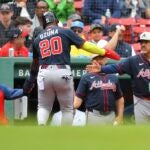Sign up for Red Sox updates⚾
Get breaking news and analysis delivered to your inbox during baseball season.
Get breaking news and analysis delivered to your inbox during baseball season.

Red Sox

Mookie Betts

Marcelo Mayer

Red Sox

Red Sox

Red Sox

Garrett Crochet

Chris Sale

Red Sox

Red Sox
| Game date | Home game | Competing team logo Competing team location | Game start time |
| This is a home game. | Logo for the New York MetsNew York | ||
| This is a home game. | Logo for the Baltimore OriolesBaltimore | ||
| This is a home game. | Logo for the Baltimore OriolesBaltimore | ||
| This is a home game. | Logo for the Baltimore OriolesBaltimore | ||
| This is a home game. | Logo for the Baltimore OriolesBaltimore |
| Team | W | L | PCT | GB |
|---|---|---|---|---|
| New York | 28 | 19 | .596 | 0 |
| Boston | 25 | 25 | .500 | 4.5 |
| Toronto | 23 | 24 | .489 | 5 |
| Tampa Bay | 22 | 26 | .458 | 6.5 |
| Baltimore | 15 | 32 | .319 | 13 |





Stay up to date with everything Boston. Receive the latest news and breaking updates, straight from our newsroom to your inbox.